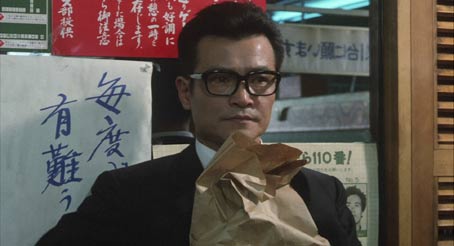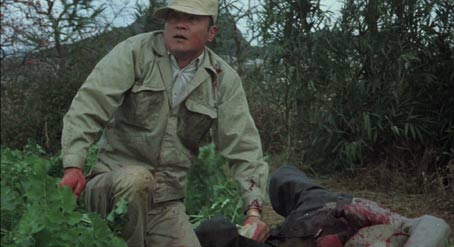|
Just as serial killers are often regarded as a modern and primarily American phenomenon (the term 'serial killer' was apparently first coined in the 1970s by either former FBI Special Agent Robert Ressler or LAPD detective Pierce Brooks, depending where your research leads you), the widespread popularity of the serial killer film is also a comparatively recent development. Well, sort of. Serial killers have been with us since the early days of dramatic cinema, thanks largely to the fame and dark allure one of the most notorious, a certain Jack the Ripper. But in film he (and it almost always is a he) remained a minor character or a background threat, providing a reason for suspicion in Hitchcock's The Lodger, or a dark conclusion for Pabst's Pandora's Box. It was Hitchcock, of course, who helped shape the genre as we now know it by making the killer the central character, first in the 1943 Shadow of a Doubt and famously in 1960 with a black-and-white low-budgeter named Psycho.

It took a while for this emerging subgenre to catch on elsewhere, hardly surprising given the hostile critical reaction Michael Powell's superlative Peeping Tom or the rejection by some countries of the whole concept of domestic serial killers – if official sources are to be believed, the phenomenon did not hit South Korea until 1986, a case that later gave rise to Bong Joon-ho's superb Memories of Murder. More recently the subgenre has been played for dark thrills, with the torture porn influence resulting in films that focus on the sometimes lingering suffering of the victims. It's still rare to find a film that invites us to identify with the killer while continuing to show his actions as repellent, and the grand master of these has to be Imamura Shohei's 1979 Vengeance is Mine [Fukushû suru wa ware ni ari]. Like Memories of Murder, it was based on a real case, that of Nishiguchi Akira, a serial killer and fraudster who was hanged for his crimes in December 1970 and whose activities inspired the Naoki prize-winning novel Vengeance is Mine by Saki Ryūzo, on which Imamura's film is directly based.
I reviewed Imamura's film back in 2005 when it was released as a Masters of Cinema DVD, and my views have not altered in the intervening years. If you're new to film and want some more detail on the story and handling then you can read that review here. Unlike Masters of Cinema's simultaneous Blu-ray release of La planète sauvage, the expansion of extra features is limited to two trailers and a textual interview with the director. In other respects this is essentially the same release as before given a high definition makeover, and a key question is thus whether the improvements to picture and sound are worth the upgrade.
Every now and then I encounter a DVD transfer that I cannot be completely objective about. I'm not talking about those whose sharpness and vivid colours make them reference discs for the wonders of digital transfers, but when a film that you've only ever seen looking visually ragged is substantially improved for its DVD release. To a critical eye, the results may not warrant comparison with a pristine modern Hollywood studio release, but to those of us who have lived with inferior television or tape versions for years, such a transfer can provoke considerable excitement. Such was certainly the case with Masters of Cinema's DVD release of Vengeance is Mine, which for me at least was something of a revelation after years of having to tolerate an indistinct and muddy 4:3 VHS version recorded from TV. And remember, this is a 1979 Japanese film that was shot largely in natural light and had to be restored from probably imperfect film materials, and thus its qualities have to be viewed and appreciated in context.

News that it was to be re-released on Blu-ray prompted some speculation in this quarter. Had Eureka tracked down an immaculate new master or sourced a fresh and digital restoration? Or was this essentially the same transfer as before but in HD rather than standard def? I'm going to go with the latter. There's certainly nothing in the accompanying booklet to suggest otherwise, and feed both transfers simultaneously into the same TV, particularly if your DVD upscaling capabilities are any good, then the differences are initially difficult to appreciate. The wide shot of the Kannawa hot springs that opens chapter 3, for example, displays a similar level of detail on both discs, and on a later montage of wanted posters, the text seems as clear on the DVD as it does on the Blu-ray. There are subtle differences in picture brightness, and the contrast feels a little less aggressive on the Blu-ray, which does tend to highlight the softness of black levels on some of the darker scenes (necessary to retain some picture information). But intermittently the resolution difference is clearly evident, notably around the 1:34 mark, where the detail on the geisha costume is very visibly crisper on the HD transfer, and at a sensible viewing distance the image as a whole has a slightly richer feel than the DVD. The bigger your HD TV, of course, thje more noticeable those differences are likely to be.
The DTS-HD Master Audio mono 2.0 track is similar to the one on the DVD with the same range restrictions and slight treble bias, but the volume is considerably lower and has a slightly more subtle feel.
As indicated above, two of the key extra features here – the Tony Rayns commentary, the Alex Cox introduction – are the same as those on the DVD, which I've already covered here.
New to the Blu-ray are the Original Japanese Teaser (3:02) and the Original Japanese Trailer (3:01), both of which have been impressively restored and have been transferred at 1080p. The other difference is the accompanying Booklet, whose content differs from its DVD predecessor, with the two previous essays replaced by a lengthy and interesting interview with Imamura by Toichi Nakata. The credits, stills and reprints from the 1979 Japanese and International Shochiku brochures that appeared in the earlier brochure are still here.
So if you already have the Masters of Cinema DVD, is it worth upgrading to the Blu-ray? That's not as easy a call as it was for La planète sauvage, whose considerably improved picture and additional extras made it a must-have. The difference between the DVD and the Blu-ray here will depend partly on the size of your screen and the upscaling capabilities of your player, with the resolution upgrade clearer in some places than others. Thus what you're getting for your money is a visible but not spectacular picture upgrade, two trailers and the Imamura interview. Perfectionists will want it anyway, as they should, and if you've not got round to getting the film yet then this is the logical one to go for.
|